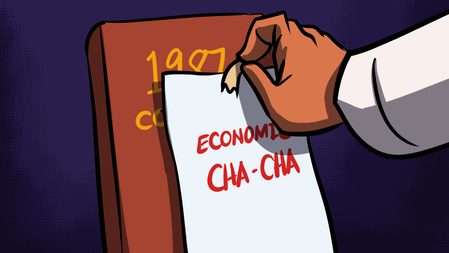SUMMARY
This is AI generated summarization, which may have errors. For context, always refer to the full article.
![[ANALYSIS] Challenges that are holding down the market](https://www.rappler.com/tachyon/2024/01/Challenges-holding-down-market-January-19-2024.jpg)
I had some exchange of thoughts about the market with veteran stockbroker Ali Yu, president and market strategist of R. S. Lim & Co., Incorporated, at the beginning of this week. While he maintains a positive outlook because of the country’s improving economic situation, he could not just dismiss the inability – or rather “hesitancy” – of the market to break out from its immediate psychological resistance trading level of 6,700 of the PSEi.
As he puts it, “this has remained a challenge.”
To recall, this trading level was almost everyone’s closing forecast for last year. But as Mark Douglas pointed out in his book, The Disciplined Trader (now an industry classic), “any trading level can be a turning point.” On the last trading day of 2023, the market stopped from its climb and slipped even lower to 6,450.04.
Like Yu, my circle of other friends and colleagues in the industry is attributing the current behavior of the market to some perceived common possible dangers.
One of this is the harm the market may suffer from the current grumblings on our local political front. When out of control, it may create greater damage to what the market has been sustaining from the present tensions in the West Philippine Sea, the war in Israel and Gaza strip, in the Red Sea and Ukraine. It could certainly spell disaster for the market.
To review, the House of Representatives has declared that among its priority projects for 2024 is the move for charter change. The Senate, for its part, has shown little enthusiasm due to differences in the focus and scope of the changes to be made. Then out of the blue, the “People’s Initiative” or PI movement came to fore.
Behind the PI movement is the so-called People’s Initiative for Reform Modernization and Action or PIRMA (the Filipino word for “signature”). This is the group that sprouted at the tail-end of the presidency of the late Fidel Ramos. They started a signature campaign for amending the Constitution, such as shifting to a parliamentary system of government and the lifting of term limits on elected officials, among others.
The “People’s Initiative or PI” is one mode for constitutional amendment provided by the Constitution. It recognizes the power of the people to propose amendments to the Constitution or to propose and enact legislations through a plebiscite called for the purpose.
The market is disturbed by the initial negative methods ascribed to the efforts for charter change. The progress of efforts to iron them out as of late, however, are encouraging.
New Cabinet movements
The recent movements in the Cabinet are received cheerfully by the industry. Among which is the appointment of former Deputy Speaker Ralph Recto to the post of finance secretary.
However, there are pressing issues the market would like the new finance secretary should immediately look at. This is aptly articulated by a former colleague in the industry and now Albay 2nd District Representative, Joey Sarte Salceda.
First is the government’s VAT digitalization efforts. “We are in the awkward position of being among the first to propose a digital services VAT, and the last in the ASEAN-6 to actually pass such a tax; “we need to address this (posthaste),” according to Salceda.
Second is the issue of tapping added revenues from electronic commerce. It is now the driving force of consumer demand. This space, according to Salceda, escapes the reach of taxation. It has remained “di minimis” to the government. But if properly addressed, it may no longer appear as something trivial but an important source of added revenues.
Of urgent need, according to Salceda, is requiring ecommerce platforms to ensure tax payment compliance of their sellers, and creating similar mechanisms for cash-on-delivery transactions.
Another concern is the tobacco excise tax collections. As pointed out by Salceda, there is an urgent need to figure out how to replace this declining source of revenue stream. In Salceda’s calculations, it could collapse by as much another P45.0 billion this year due to “substitution effects” from vaping.
Salceda recalled that Recto was an advocate in the past of using Republic Act 8794, otherwise known as the Motor Vehicle User Charge (MVUC) or the Anti-Overloading Act of the Philippines, to finance public transport.
In this connection, Salceda is optimistic about the proposals he spearheaded to update the MVUC rates which can be used “to heavily subsidize the jeepney modernization program.”
Fearless market forecasts
As of this writing, the market has not broken the 6,700 level. In fact, it even receded a few more points lower than this target.
Yet, the enthusiasm of all those I have talked to, has not diminished. As Yu expressed it, “we should see some stronger support soon.” This is because “this is the quarter season to position for the year,” he added.
My longtime friend stockbroker, Rene de los Reyes of Abacus Capital & Investment Corporation, harbors an unconditional positive outlook as well. He is confident that the doubts around charter change will be resolved out of the honesty of the intentions on the matter.
According to De los Reyes, the market breakout will be triggered by the reduction of interest rates, which to him is just “a matter of when, not if.”
Jofer Gaite, president and chief trader of Westlink Global Equities, Inc., likewise expressed confidence that the market is bound to go higher. “This will be triggered by the return of foreign funds, together with the easing of interest rates, and actual GDP growth.”
The projected El Niño in the summer months, according to Gate, might cause a pullback as rice production takes a hit. As everyone has learned, “inflation ticks higher when rice prices rise.”
The most bullish among my young colleagues is Joel de la Peña, market strategist and chief trader of H.E. Bennett Securities, Inc. Out of the market’s daily transactions, he considers the market to have broken the 6,700 level for all intents and purposes.
What is holding back the market from actually doing so, according to him, is the impact of the trading activities of foreign investors. They tend to sell when it is about to hit it and buy back after retreating several points lower. A great believer in what the Maharlika Investment Fund can do to prop up the market, he awaits with bated breath the scheduled roll out of its funds by March. He is particularly excited by the expressed intention of the MIF to invest in Synergy Grid & Development Phils., Inc. (SGP) – his star stock pick in addition to another favorite, Robinsons Land Corporation (RLC).
De la Peña sees the market to climb before the second quarter and estimates that the PSEi will hit the 7,000 level by midyear.
Information on SGP
The following information on SGP that is literally lifted from the PSE’s website will possibly make you understand Dela Peña’s great enthusiasm on the stock: “On December 20, 2019, SGP entered into a share swap transaction with the stockholders of One Taipan Holdings, Inc. (OTHI) and Pacifica2 Holdings, Inc. (P21).
As a result, SGP owned 67% of the outstanding shares of each OTHI and P21. OTHI owns controlling shares in Monte Oro Grid Resources Corporation (MOGRC), which holds 30% plus one share in National Grid Corporation of the Philippines (NGCP). P21 owns controlling shares in Calaca High Power Corporation (CHPC), which in turn owns 30% minus one share in NGCP.
The share swap transaction was undertaken to formally consolidate the two major shareholders’ ownership and control of NGCP through a common corporate structure. Accordingly, the effective ownership of SGP in NGCP will be 40.20%, with control of 60% voting rights through subsidiaries MOGRC and CHPC.”
Don’t miss out on succeeding articles. More fearless market forecasts and stock recommendations will be coming. – Rappler.com
The article has been prepared for general circulation for the reading public and must not be construed as an offer, or solicitation of an offer to buy or sell any securities or financial instruments whether referred to herein or otherwise. Moreover, the public should be aware that the writer or any investing parties mentioned in the column may have a conflict of interest that could affect the objectivity of their reported or mentioned investment activity. You may reach the writer at densomera@yahoo.com.
Add a comment
How does this make you feel?





![[Vantage Point] Philippine economic reforms run into headwinds](https://www.rappler.com/tachyon/2024/05/ph-economic-headwind-may-2024.jpg?resize=257%2C257&crop_strategy=attention)
![[In This Economy] A counter-rejoinder in the economic charter change debate](https://www.rappler.com/tachyon/2024/04/TL-counter-rejoinder-apr-20-2024.jpg?resize=257%2C257&crop=267px%2C0px%2C720px%2C720px)
![[ANALYSIS] Time to take the contrarian side](https://www.rappler.com/tachyon/2024/07/thought-leaders-time-to-take-the-contrarian-side-072520224.jpg?resize=257%2C257&crop=452px%2C0px%2C1080px%2C1080px)
![[ANALYSIS] Every inch of the market’s climb is a battle now but may soon prove better](https://www.rappler.com/tachyon/2024/07/thought-leaders-market-climb-battle.jpg?resize=257%2C257&crop=324px%2C0px%2C720px%2C720px)
![[ANALYSIS] The West Philippine Sea dispute and the stock market’s performance](https://www.rappler.com/tachyon/2024/06/thought-leaders-west-ph-sea-dispute-and-market-performance.jpg?resize=257%2C257&crop=134px%2C0px%2C720px%2C720px)


There are no comments yet. Add your comment to start the conversation.